#modernist playground
Explore tagged Tumblr posts
Text
Supporters of Jair Bolsonaro mount an insurrection in Brazil
Questions will be asked about whose side the police were on

IF THE GOVERNMENT of Brazil’s new president, Luiz Inácio Lula da Silva, thought that his inauguration on January 1st would put an end to protests by supporters of Jair Bolsonaro, the man he replaced, the events of January 8th showed that to be wishful thinking. At around 3pm in Brasília, the capital, thousands of bolsonaristas stormed the modernist buildings of Congress and the Supreme Court, along with the presidential palace, breaking windows and damaging furniture. Many of the insurrectionists had been camped out in front of federal army headquarters since October, when Mr Bolsonaro lost a tight election to Lula, as the leftist current president is known. Led by Mr Bolsonaro, a right-wing populist, to believe that the election was stolen, they begged the army to stage a coup.
On Sunday, perhaps realising that no coup was coming, the bolsonaristas decided to take matters into their own hands. Although the rampage occurred during a congressional recess, meaning the invaded buildings were mostly empty, it bore striking similarities to the storming of the United States Capitol on January 6th 2021 by followers of Donald Trump. In the Senate, the bolsonaristas climbed onto the stage and slid down it as if it were a playground slide. In the Supreme Court, they ripped a justice’s door from its hinges and posted photos of themselves on social media hoisting it in the air as if it were a trophy.
But if the riots in Washington revealed lapses in police intelligence and co-ordination, their Brazilian counterpart suggested something more worrying. While there is no evidence that the police were complicit in the insurrection, they were, at the very least, passive. Shortly after the invasion of Congress began in Brasília, a group of officers were caught on film chatting with protesters, taking selfies and filming the chaos rather than acting to stop it. Requests for back-up from the head of the Senate police to the governor of the federal district of Brasília, who is an ally of Mr Bolsonaro, were ignored until late in the afternoon. (In an apparent attempt to save face later, the governor fired his security secretary, who was Mr Bolsonaro’s justice minister.)
Continue reading.
#brazil#politics#brazilian politics#democracy#brazilian elections#brazilian elections 2022#january 8#police#mod nise da silveira#image description in alt
5 notes
·
View notes
Text

Churchill Gardens estate in Pimlico, London, 1978
This playground is on the modernist Churchill Gardens estate designed by Powell and Moya, but clearly built at a later date. Before these postwar playgrounds were built, children would have been playing in the bomb sites left after the war. It’s possible the architects were referencing that in their design. All captions by Simon Terrill
Photograph: John Donat/RIBA
5 notes
·
View notes
Text
In the uncharted territory of the digital age, architects are using social media platforms to celebrate design innovation, explore new ideas, and connect with a global audience. However, our new architectural quandary isn't about mastering the science of steel or the mathematics of curves—it’s about mastering the art of online engagement. This means constructing your online presence as diligently as you would a building, considering all aspects of aesthetic appeal, structural integrity, and practical functionality. Online engagement is as vital to the architectural profession as foundational design principles, sketching ideas, or understanding construction techniques. As such, the purpose of this discussion is to underscore the import of "Architectural Aesthetics on Social Media." ### Redefining Spatial Aesthetics The architectural landscape is no longer confined to physical spaces. Today, it extends to the 2D covers of your Instagram posts, Facebook galleries, and LinkedIn profiles. The digital terrain is where architects can deftly showcase their creations, connecting to both clients and the wider architectural community. Here, aesthetics plays a leading role. As architects, we're impassioned curators of spaces, both physical and digital, making social media an ideal playground for visual narratives. The translation of physical aesthetics to digital media relies on quality visual content and adept storytelling. A finely-tuned balance between these elements leads to successful online engagement. ### Adding Structure to Stories Architects leverage their training in composition, form, and space to structure a narrative that communicates their design philosophy. Social media platforms act as digital sketchbooks, portfolios, and journals, providing space to frame conceptual thoughts, design processes, and project outcomes. Compelling stories are the backbone of captivating social media content. They are what garner 'likes,' comments, shares, and, more importantly, discussions. Focus on incorporating behind-the-scenes glimpses, and stories behind your designs to craft relatable, inspiring content. ### Integrating SEO Principles Mastering the principles of SEO allows architectural firms to gain visibility and reach. Optimizing social media posts with relevant keywords enhances their ranking on search engines and increases the probability of being discovered. Inclusion of industry-specific terms like 'brutalist architecture,' 'modernist design,' or 'postmodern aesthetic' can draw traffic to your content. However, it is crucial to artfully weave these keywords into your narrative to maintain readability and audience engagement. Remember, your audience extends beyond search engines. It includes real people seeking a connection, inspiration, and answers to their architectural queries. ### Cultivating Engagement Your objective is not only creating fine visual content; it's fostering an environment that invites dialogue and interaction. Remember, every 'like,' comment, or share is an engagement opportunity. Provoking thoughts, stimulating discussions, and responding promptly to enquiries will make your audience feel valued and increase your online presence. In architectural terms, think of it as adding a ‘pull factor’ to your designs. ### Value of Online Presence to Architectural Practice An architect’s online presence is more than a marketing tool—it’s a brand-building resource. It helps professionals resonate their unique vision and perspective, all the while fostering connections on a global stage. As architects, we must embrace the digital, learning to translate complex architectural aesthetics into compelling online narratives. In conclusion, Architectural Aesthetics on Social Media can no longer be seen as a periphery to architectural practice. Instead, it forms an integral part of the profession, as crucial as any design tool or principle. By mastering the art of online engagement, architects can shape their digital edifice, standing tall amidst the cluttered digital skyline of the 21st century.
Case Study: The Transformation of Zaha Hadid Architects on Instagram Zaha Hadid Architects (ZHA) is an international architectural firm renowned for its innovative and pioneering designs. However, despite having a wealth of stunning projects, it was struggling to effectively translate that into a compelling social media presence, particularly on Instagram. Recognizing the potential benefits of a strong online presence, ZHA entrusted its social media management to an expert team who optimized their strategy based on the principles of architectural aesthetics, thereby boosting their audience engagement and branding. Highlighting Unique Design Elements Instead of merely posting images of their projects, ZHA began focusing on unique design aspects in their posts. The close-up shots illustrated the firm's attention to detail, creating an immediate impression of professionalism and thoroughness. This active showcasing of their unique design aesthetic engaged followers who appreciated fine architecture and design, thus servicing core niche segments more effectively. Quality over Quantity Initially, the firm was focusing on posting frequently with an aim to increase visibility. However, they soon realized that the quality of posts mattered more than the frequency. High-resolution, professionally taken photos that provided varied perspectives of their design were preferred. This change in strategy aligned with the principle of quality over quantity, which resonated deeply with architecture aficionados who value precision and meticulousness. 1. Take high-quality photographs of your work. This could mean investing in a professional photographer who can capture the essence of your designs. 2. Focus on unique elements of your design. Showcasing your innovation can influence potential clients and helps in setting you apart from your competitors. Narrative in Captions Detailed architectural descriptions, the inspiration behind each project, and even site-specific challenges were included in the captions, providing an opportunity for followers to learn more about ZHA’s design process. This storytelling approach helped to cultivate a stronger connection between the followers and ZHA. SEO-based strategy The team also incorporated SEO principles into their posting strategy. By using relevant and highly-searched hashtags, they started improving their visibility in search results. Relevant geotags were also used, attracting attention from local architecture enthusiasts and potential clients in specific areas. 1. Use storytelling techniques to engage your followers on a deeper level. 2. Incorporate SEO strategies, such as effective hashtag use and geotagging, to increase your visibility. In just six months, ZHA saw a substantial increase in their follower count, degrees of interaction, and new business inquiries. By focusing on architectural aesthetics, delivering quality content consistently, using SEO strategies, and creating engaging captions, ZHA transformed their Instagram account into a powerful marketing tool. This case study of ZHA perfectly encapsulates how architectural firms can leverage their unique aesthetics to master online engagement. By considering these strategies and principles, other firms can also enhance their social media presence and, by extension, their brand and business potential. "Ready to elevate your social media game with captivating architectural aesthetics? Take the first step towards mastering the art of online engagement now! Transform spectators into potential clients today!" Start Your Digital Transformation Now! "Did you know that over 90% of millennials and around 77% of Generation X are active social media users? Surprisingly, this is where modern architects are winning. A recent survey revealed that 80% of architectural firms use social media for their businesses, tying into the high demand for visually stimulating content online."
0 notes
Text
Savoring the Globe: Culinary Journeys Worldwide


Embark on extraordinary Culinary Journeys Worldwide with our immersive guide! Discover the rich tapestry of global flavors, from sizzling street food in Bangkok to Michelin-starred delicacies in Paris. Unleash your inner foodie as we unravel hidden culinary gems and share expert tips on navigating diverse gastronomic landscapes. Whether you're a seasoned traveler or an armchair adventurer, our article promises a feast for your senses. Elevate your culinary prowess, explore exotic tastes, and create unforgettable memories.
Culinary Journeys Worldwide

1. Tokyo, Japan: Sushi Symphonies and Ramen Revelries Tokyo, the epicenter of Japanese culinary artistry, is a haven for food enthusiasts. Dive into the world of sushi, where every piece is a masterpiece, or slurp savory ramen in bustling noodle joints. From the precision of kaiseki dining to the lively izakayas, Tokyo's culinary scene is a harmonious blend of tradition and innovation. 2. Paris, France: Patisseries and Michelin Stars Known as the culinary capital of the world, Paris is a playground for gastronomes. Indulge in flaky croissants and delicate macarons from charming patisseries. For an extraordinary dining experience, venture into Michelin-starred restaurants where French haute cuisine reaches its zenith. Parisian dining is not just a meal; it's a celebration of artistry on a plate. 3. Bangkok, Thailand: Street Food Extravaganza Bangkok's vibrant street food culture is a journey for the senses. Wander through bustling markets and savor the symphony of flavors in every bite. From pad Thai to tom yum, Thailand's capital offers an explosion of tastes, aromas, and textures. Dive into the world of Thai street food, where each dish tells a story of heritage and culinary mastery. 4. Marrakech, Morocco: Spice-Infused Delights Marrakech, with its bustling souks and vibrant spices, invites travelers on a culinary adventure through the heart of North Africa. Sample the tagines infused with saffron and cumin, relish the sweetness of traditional pastries, and savor mint tea in the midst of lively markets. Morocco's rich culinary tapestry unfolds in the vibrant streets of Marrakech. 5. New York City, USA: Melting Pot of Flavors In the city that never sleeps, culinary options are as diverse as its inhabitants. From iconic New York-style pizza to upscale dining experiences, NYC is a melting pot of global flavors. Explore the vibrant food scene in neighborhoods like Chinatown, Little Italy, and Harlem, where each bite reflects the city's rich cultural tapestry. 6. Barcelona, Spain: Tapas and Catalonian Cuisine Barcelona's culinary scene is a celebration of Catalonian traditions and avant-garde creativity. Dive into the world of tapas, where small plates burst with flavors and textures. Explore local markets, such as La Boqueria, for fresh produce and seafood. From the traditional paella to modernist culinary creations, Barcelona is a paradise for food enthusiasts. 7. Istanbul, Turkey: Ottoman Delights and Street Eats Istanbul, where East meets West, is a culinary crossroads offering a feast for the senses. Indulge in kebabs and mezes in the historic Sultanahmet district, or explore the vibrant street food scene along the Bosphorus. Turkish delight, baklava, and aromatic teas add a sweet touch to Istanbul's rich culinary heritage. 8. Oaxaca, Mexico: Mole and Mezcal Marvels Oaxaca, a UNESCO-designated Creative City of Gastronomy, is a jewel in Mexico's culinary crown. Dive into the world of mole, a rich and complex sauce that reflects the region's indigenous roots. Sip on smoky mezcal, explore vibrant markets, and savor the diverse flavors of Oaxacan cuisine, where each dish is a tribute to tradition and innovation. 9. Cape Town, South Africa: Culinary Fusion by the Sea Cape Town's culinary scene reflects the city's diverse heritage and stunning coastal landscapes. Indulge in fresh seafood along the Atlantic Seaboard, savor Cape Malay flavors in Bo-Kaap, and explore vibrant markets for a taste of South African gastronomy. Cape Town's culinary fusion captures the essence of the Rainbow Nation. 10. Bangalore, India: Spices and Street Food Bliss In the heart of South India, Bangalore is a culinary hub where traditional flavors meet modern innovation. Sample the aromatic spices of South Indian cuisine, indulge in street food delights like dosa and chaat, and explore the city's dynamic café culture. Bangalore's culinary landscape is a journey through the diverse flavors of the subcontinent. Embarking on a culinary journey worldwide is not just about eating; it's a celebration of culture, history, and the universal joy of shared meals. From the refined elegance of Paris to the vibrant chaos of Bangkok's street markets, each destination offers a unique gastronomic adventure. So, pack your appetite and embark on a global feast for the palate, where every dish tells a story and every bite is a journey into the heart of a culture.
Global foodie destinations

For those with a passion for exploring the world through their taste buds, the journey is just as important as the destination. Global foodie destinations beckon with a promise of diverse flavors, culinary traditions, and immersive dining experiences. Join us as we embark on a gastronomic adventure around the globe, unveiling the must-visit places that every food enthusiast dreams of exploring. 1. Tokyo, Japan: A Symphony of Sushi and Ramen Tokyo, the culinary capital of Japan, offers a captivating blend of tradition and innovation. Dive into the world of sushi, where the freshest seafood meets the skillful hands of master chefs. Explore the narrow alleys filled with ramen joints, each serving a unique and flavorful broth. Tokyo's food scene is a harmonious symphony that tantalizes the taste buds and celebrates the art of Japanese cuisine. 2. Barcelona, Spain: Tapas and Flamenco Nights In the heart of Catalonia, Barcelona is a foodie's paradise where every street corner tells a story of culinary delight. Indulge in the tradition of tapas, small plates bursting with flavors that invite communal dining. Pair your tapas with a glass of local wine and immerse yourself in the vibrant atmosphere of Barcelona's bustling food markets. From patatas bravas to paella, the city's culinary offerings are a celebration of Spanish gastronomy. 3. Marrakech, Morocco: Spice-Infused Adventures Marrakech, with its vibrant souks and aromatic spices, beckons foodies to embark on a sensory journey through Moroccan cuisine. Explore the labyrinthine markets, where the air is filled with the scent of cumin, saffron, and cinnamon. Savor tagines with tender meats and dried fruits, indulge in sweet pastries, and sip on mint tea in the heart of bustling medinas. Marrakech is a tapestry of flavors that transports you to the heart of North Africa. 4. Bangkok, Thailand: Street Food Extravaganza Bangkok's street food scene is a sensory explosion, a riot of colors, aromas, and tastes. Venture into crowded markets and street corners where vendors dish out authentic Thai delicacies. From the iconic pad Thai to the spicy tom yum soup, Bangkok's street food is a feast for the adventurous palate. Immerse yourself in the vibrant street food culture, where each bite is a journey into the rich tapestry of Thai cuisine. 5. New York City, USA: A Melting Pot of Culinary Diversity In the city that never sleeps, the culinary options are as diverse as its inhabitants. From iconic New York-style pizza to authentic bagels, the city is a melting pot of global flavors. Explore the diverse neighborhoods, each offering a unique culinary experience, from the savory delights of Chinatown to the soulful dishes of Harlem. New York City is a foodie's haven, where world cuisines converge in a harmonious blend. 6. Oaxaca, Mexico: Mole and Mezcal Delights Nestled in the heart of Mexico, Oaxaca is a gastronomic treasure trove where ancient traditions meet contemporary culinary creativity. Dive into the world of mole, a complex and flavorful sauce that defines Oaxacan cuisine. Sip on smoky mezcal, explore vibrant markets filled with colorful ingredients, and savor the rich tapestry of flavors that make Oaxaca a must-visit destination for food enthusiasts. 7. Paris, France: Haute Cuisine and Charming Patisseries Paris, the epitome of elegance and refinement, is a timeless destination for culinary connoisseurs. Indulge in the artistry of French haute cuisine in Michelin-starred restaurants, or stroll through charming neighborhoods to discover local patisseries. From buttery croissants to delicate macarons, Parisian pastries are a testament to the city's commitment to culinary excellence. Paris is a dream destination where every meal is a celebration of culinary art. 8. Istanbul, Turkey: Ottoman Delights and Bosphorus Views Istanbul, where East meets West, is a culinary crossroads that captivates with its rich history and diverse flavors. Explore the markets of the Grand Bazaar, where spices, teas, and sweets create a kaleidoscope of scents and colors. Indulge in traditional Turkish delights, savor kebabs, and enjoy the unique experience of dining along the Bosphorus. Istanbul's culinary scene is a journey through the tastes of both continents. 9. Cape Town, South Africa: Fusion by the Sea Cape Town, with its stunning coastal landscapes, offers a culinary experience that reflects the city's diverse heritage. Enjoy fresh seafood along the Atlantic Seaboard, savor Cape Malay dishes in Bo-Kaap, and explore vibrant markets filled with local produce. Cape Town's cuisine is a fusion of flavors that captures the essence of the Rainbow Nation, making it a top destination for food enthusiasts. 10. Bangalore, India: Spices and Street Food Bliss In the heart of South India, Bangalore is a dynamic city that showcases the rich tapestry of Indian flavors. Explore the bustling street food scene, where dosas, chaats, and vadas tempt the taste buds. Immerse yourself in the aromatic spices of South Indian cuisine, and experience the city's vibrant café culture. Bangalore is a melting pot of regional Indian cuisines, offering a diverse and delightful culinary journey. Embarking on a culinary journey to global foodie destinations is an invitation to savor the world's flavors, traditions, and culinary stories. Each destination, with its unique gastronomic offerings, presents an opportunity for food enthusiasts to connect with the heart and soul of a place. Whether you're exploring the street markets of Bangkok or indulging in Michelin-starred dining in Paris, the world is a vast and delectable playground for those who seek to experience it one bite at a time.
Culinary tours around the world

For food enthusiasts, there's no better way to explore the world than through the lens of its culinary offerings. Culinary tours have become a popular travel trend, allowing globetrotters to indulge their taste buds in authentic, local flavors. Join us as we embark on a gastronomic journey, uncovering the most enticing culinary tours around the world that promise not just a meal but an unforgettable experience. 1. Tokyo, Japan: Sushi Workshops and Izakaya Adventures A culinary tour of Tokyo is a rendezvous with precision and artistry. Delve into sushi-making workshops where you'll learn the delicate art of crafting nigiri and sashimi. Venture into izakayas, traditional Japanese pubs, for a taste of small, flavorful plates paired with local sake. Tokyo's culinary scene is an exploration of both the refined and the casual, reflecting the city's diverse gastronomic offerings. 2. Paris, France: Haute Cuisine and Boulangerie Bliss A culinary tour in the City of Lights is a sensory delight. Join guided tours through iconic patisseries, where flaky croissants and decadent pastries await. Indulge in the elegance of haute cuisine with guided visits to Michelin-starred restaurants, allowing you to savor the epitome of French culinary art. Parisian culinary tours are a journey into the heart of gastronomic excellence. 3. Marrakech, Morocco: Spice Markets and Tagine Tastings Marrakech's bustling souks and aromatic spice markets offer an immersive culinary experience. Join guided tours through the labyrinthine alleys, where vibrant stalls showcase the ingredients that define Moroccan cuisine. Engage in tagine-making classes, unlocking the secrets behind the rich and flavorful stews. Culinary tours in Marrakech are a fusion of history, culture, and tantalizing flavors. 4. Bangkok, Thailand: Street Food Safari and Floating Markets A culinary tour in Bangkok is an adventure through the city's vibrant street food culture. Traverse bustling markets and street corners with local guides who unravel the stories behind each dish. Indulge in the fiery delights of tom yum soup, pad Thai, and satay skewers. Cruise through floating markets, where the freshest produce and local snacks beckon. Bangkok's culinary tours promise a whirlwind of tastes and textures. 5. Barcelona, Spain: Tapas Trails and Mercado Explorations Barcelona's culinary tours are a celebration of tapas, the small plates that define Spanish social dining. Join guided tapas trails through the city's lively neighborhoods, sampling an array of flavors from patatas bravas to jamón ibérico. Explore the vibrant markets like La Boqueria, where fresh produce and seafood create a colorful spectacle. Barcelona's culinary scene is a journey through the heart of Catalonian gastronomy. 6. Oaxaca, Mexico: Mezcal Tastings and Mole Adventures A culinary tour in Oaxaca is an exploration of Mexico's rich culinary heritage. Engage in mezcal tastings, where the smoky spirit reveals the art of traditional distillation. Join mole adventures, discovering the intricate process of preparing the complex sauce that defines Oaxacan cuisine. Culinary tours in Oaxaca showcase the region's indigenous roots and the vibrant tapestry of flavors. 7. New York City, USA: Food Truck Safaris and Gourmet Districts New York City's culinary tours are a testament to its diverse food scene. Embark on food truck safaris through bustling neighborhoods, sampling gourmet delights on wheels. Explore gourmet districts like Chelsea Market, where artisanal products and diverse cuisines converge. From the iconic New York pizza to international delicacies, NYC's culinary tours offer a taste of the world in the city that never sleeps. 8. Istanbul, Turkey: Bosphorus Dining and Baklava Trails A culinary tour in Istanbul is a voyage through the crossroads of East and West. Enjoy Bosphorus dining experiences, savoring Turkish delights with panoramic views. Follow baklava trails through historic neighborhoods, indulging in the sweet layers of this iconic dessert. Istanbul's culinary tours showcase the city's rich history, culinary traditions, and the warm hospitality of Turkish culture. 9. Cape Town, South Africa: Wine Tastings and Seafood Safaris Cape Town's culinary tours are a fusion of breathtaking landscapes and diverse flavors. Join wine tastings in the renowned vineyards of Stellenbosch, where award-winning wines complement stunning views. Embark on seafood safaris along the Atlantic Seaboard, savoring fresh catches in the shadow of Table Mountain. Culinary tours in Cape Town capture the essence of South Africa's gastronomic diversity. 10. Bangalore, India: Street Food Exploration and Spice Markets A culinary tour in Bangalore is a journey through the vibrant street food culture of South India. Explore bustling markets and street corners with local guides, sampling dosas, vadas, and chaats. Immerse yourself in the spice markets, where aromatic flavors define the region's culinary identity. Bangalore's culinary tours are a celebration of the city's diverse and dynamic food scene. Culinary tours around the world offer not just a chance to savor exquisite dishes but also an opportunity to immerse yourself in the culture, history, and traditions of each destination. From the refined elegance of Paris to the vibrant chaos of Bangkok's street markets, these tours promise a feast for the senses, creating lasting memories for the global foodie explorer. Embark on these culinary odysseys, and let your taste buds be your guide to the heart of each city's culinary soul.
Authentic street food experiences

Street food isn't just about satisfying hunger; it's a journey into the heart of a culture, a dance of flavors that transcends the ordinary. Authentic street food experiences offer a passport to the soul of a destination, providing a sensory feast that leaves an indelible mark on the traveler's memory. Join us as we explore the vibrant tapestry of street food around the world, from bustling markets to hidden alleyways, unlocking the secrets of authenticity and flavor. 1. Bangkok, Thailand: The Kingdom of Street Food Extravaganza Known as the street food capital of the world, Bangkok's bustling markets and vibrant street corners offer a symphony of flavors. From the iconic pad Thai to the spicy tom yum soup, each dish tells a story of Thai culinary heritage. Join the locals at street stalls and indulge in grilled satay skewers, savory noodle dishes, and sweet mango sticky rice. Bangkok's street food is an explosion of taste, color, and authenticity. 2. Marrakech, Morocco: A Spicy Adventure in the Medina Marrakech's historic medina is a sensory delight for food enthusiasts. Navigate through labyrinthine alleys filled with the aromas of cumin, coriander, and saffron. Engage with local vendors offering tagines with succulent meats, fluffy couscous, and flavorful pastries like the iconic pastilla. Marrakech's street food experience is a spice-infused journey that mirrors the richness of Moroccan culture. 3. Mexico City, Mexico: Tacos and Tantalizing Tostadas Mexico City's street food scene is a vibrant tapestry of colors and flavors. Dive into bustling markets and street corners where taco stands beckon with an array of fillings, from tender carnitas to spicy chorizo. Savor the crunch of tostadas topped with ceviche or guacamole. Read the full article
0 notes
Text
Solo Sojourns: Embracing Adventure in the Best Solo Travel Destinations
Embarking on a solo journey is a transformative experience that allows individuals to discover themselves amidst new landscapes, cultures, and adventures. Solo travel is an opportunity for self-reflection, personal growth, and the freedom to chart one's own course. In this guide, we explore some of the best solo travel destinations, each offering a unique blend of excitement, cultural enrichment, and the chance to forge new connections in the world.

1. Reykjavik, Iceland: A Solo Expedition into the Arctic Wonderland
Reykjavik, the capital of Iceland, beckons solo travelers with its enchanting blend of natural wonders and vibrant city life. The land of fire and ice, Iceland offers surreal landscapes, including geysers, waterfalls, and the mesmerizing Northern Lights. Solo explorers can traverse the Golden Circle, relax in the Blue Lagoon, and wander through Reykjavik's charming streets adorned with colorful houses. Iceland's commitment to safety makes it an ideal destination for those venturing out on their own, and the warmth of its people adds a touch of hospitality to the Arctic experience.
2. Kyoto, Japan: A Solo Sojourn through Timeless Tranquility
Kyoto, with its timeless beauty and cultural richness, is a haven for solo travelers seeking tranquility and reflection. The city's historic temples, traditional tea houses, and serene gardens provide a peaceful escape from the bustling world. Solo sojourners can participate in a traditional tea ceremony, explore the iconic Fushimi Inari Shrine, and wander through the enchanting Arashiyama Bamboo Grove. The city's safety, efficient public transport, and the welcoming nature of the locals make Kyoto an ideal destination for those embracing the solo travel experience.
3. Queenstown, New Zealand: Adrenaline and Scenic Serenity
For solo travelers seeking a perfect blend of adrenaline-pumping activities and breathtaking landscapes, Queenstown in New Zealand is an unparalleled destination. Nestled on the shores of Lake Wakatipu and surrounded by the Southern Alps, Queenstown offers a playground for adventure enthusiasts. Solo sojourners can bungee jump off the Kawarau Bridge, explore the nearby Fiordland National Park, or embark on a scenic cruise. The friendly Kiwi hospitality ensures a welcoming atmosphere for solo travelers, encouraging them to embrace the spirit of adventure.
4. Barcelona, Spain: A Solo Stroll through Architectural Marvels
Barcelona, with its unique blend of modernist architecture, historic charm, and vibrant street life, is a solo traveler's delight. The city, adorned with the works of Antoni Gaudí, invites exploration through iconic landmarks like Sagrada Familia and Park Güell. Solo sojourners can wander down the lively La Rambla, savor tapas in local markets, and relax on the city's Mediterranean beaches. Barcelona's cosmopolitan atmosphere, extensive public transportation, and a thriving arts scene make it an ideal destination for those seeking a solo stroll through architectural marvels.
5. Chiang Mai, Thailand: Cultural Immersion in the Northern Gem
Chiang Mai, nestled in the mountainous region of Northern Thailand, offers a perfect blend of cultural immersion and natural beauty for solo travelers. The city's ancient temples, bustling markets, and the annual Yi Peng Lantern Festival create an enchanting atmosphere. Solo sojourners can partake in traditional Thai cooking classes, explore the historic Old City, and venture into the surrounding lush landscapes. Chiang Mai's affordability, welcoming locals, and the prevalence of solo travelers make it a hub for those seeking a transformative journey through the heart of Thailand.
6. Melbourne, Australia: Arts, Cuisine, and Urban Exploration
Melbourne, known for its vibrant arts scene, diverse culinary offerings, and eclectic neighborhoods, is an ideal destination for solo travelers with an appetite for urban exploration. The city boasts street art-filled laneways, trendy cafes, and cultural events throughout the year. Solo sojourners can attend performances at the Arts Centre, sample multicultural cuisines in Queen Victoria Market, and explore the vibrant neighborhoods of Fitzroy and St Kilda. Melbourne's emphasis on inclusivity and its well-developed public transportation system make it an accessible and enriching destination for solo travelers.
7. Cape Town, South Africa: A Solo Safari into Scenic Diversity
Cape Town, situated at the tip of the African continent, offers solo travelers a captivating journey into scenic diversity, rich history, and wildlife adventures. The iconic Table Mountain provides a panoramic backdrop to the city's vibrant waterfront, historic neighborhoods, and cultural landmarks. Solo sojourners can explore the Cape of Good Hope, visit the penguins at Boulders Beach, and take a cable car ride to the summit of Table Mountain for breathtaking views. Cape Town's friendly locals, diverse attractions, and the opportunity for solo safaris make it an enticing destination for those seeking exploration at the southern tip of Africa.
Conclusion: Crafting Your Solo Symphony
Solo travel is a symphony of self-discovery, cultural immersion, and the thrill of charting one's own course. Each destination in this guide offers a unique movement in the solo symphony, inviting travelers to embrace adventure, reflect on personal growth, and forge connections with the world. Whether amidst the natural wonders of Iceland, the cultural richness of Kyoto, or the urban vibrancy of Melbourne, solo sojourners can craft their own symphony of exploration, creating lifelong memories and discovering the transformative power of solo travel.
0 notes
Text
Top Salons in Ocean Park, California
Ocean Park is edged by a broad beach, popular with sunbathers, surfers, and volleyball players. Joggers and bikers use the beachside path, while parks offer playgrounds and picnicking, and vegetarian eateries line Main Street. The area is dotted with modernist apartments and Craftsman bungalows, and the California Heritage Museum, in a Victorian home, shows modern art and hosts a weekly gathering of food trucks.

Miakel Bishay Salon
Miakel Bishay Salon is a Santa Monica based Hair Salon that offers a full menu of hair and color services in an upscale sleek NY style salon. Santa Monica and Venice know Miakel Bishay as a welcoming local Santa Monica Salon with a true neighborhood salon experience. Stylists get to know you, always remember your name and you're likely to run into friends and neighbors while getting your hair done and sipping on some wine.

Our Santa Monica Hair Stylists are trained in the top schools from Vidal Sassoon to Paul Mitchell, and Redken. Miakel Bishay studied at Vidal Sassoon and perfected his skills under the exacting eye of Sasha Guest. Master stylist offer over 10 years of hair styling and color experience and each bring something unique to the salon. Junior stylists are hand picked by Miakel himself and are amongst the most promising new hair stylists in Santa Monica.
Miakel's team of top Santa Monica Stylists are professionally trained in the best schools around the world. Miakel Bishay personally studied at Vidal Sassoon and perfected his skills under the exacting eye of Sasha Guest. Master Stylists have been trained in schools ranging from Vidal Sassoon to Redken and offer over 10 years of hair styling and color experience. Junior Stylists have been hand-picked by Miakel and are amongst the most promising new stylists in Santa Monica.
Bombshell Salon

We opened our doors in 2013 and have considered ourselves a part of the beautiful Santa Monica community ever since. We are home to a collective of dedicated, educated, and talented stylists who value their craft and believe in being a part of a supportive team. Bombshell is inspired to create an environment that is full of positive energy and compassionate individuals. Our goal at Bombshell is to provide our clients with a luxurious, five-star experience— whether you envision relaxed, beach hair waves or a more polished, modern look, we promise to listen. We take pride in the work that we do and approach all things with personality, versatility, and creativity. We value the importance of professionalism and education to elevate the beauty industry and that is why we believe in doing all we can to help you achieve the exact look you desire.

Choose Your Horizon provides the best Ketamine Therapy Los Angeles. Ketamine therapy is a treatment for depression and anxiety that has been used for several years in the US and Europe. It is a fast-acting treatment for depression, which can take effect within one or two hours of your first injection. The effects of ketamine last from one to several days, depending on how much you use and how often.
Choose Your Horizon 4136 Del Rey Ave, Marina Del Rey, CA 90292 +1 410 886 7398 https://www.chooseketamine.com/ https://www.google.com/maps?cid=10854176009822741710
0 notes
Text
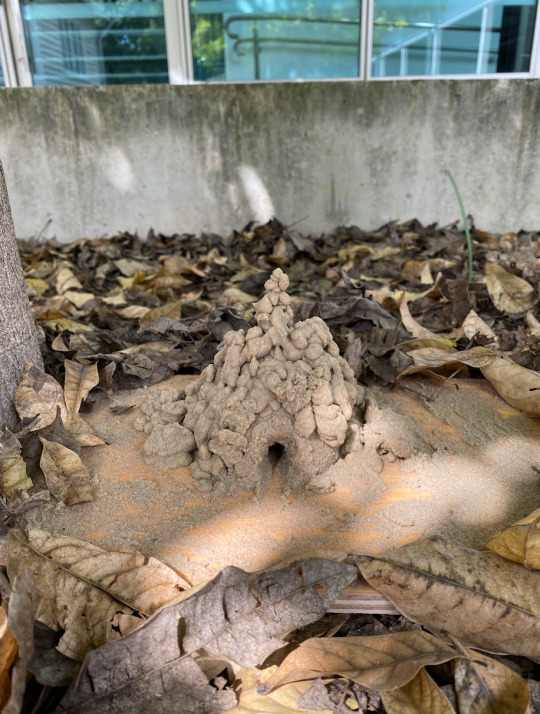
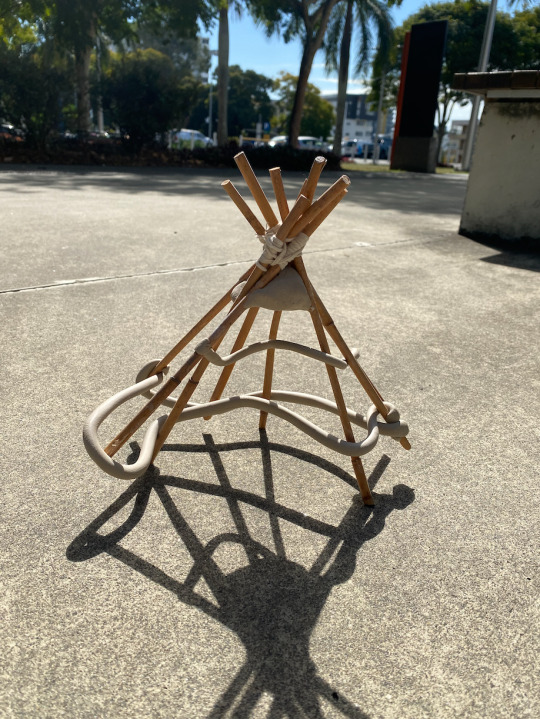

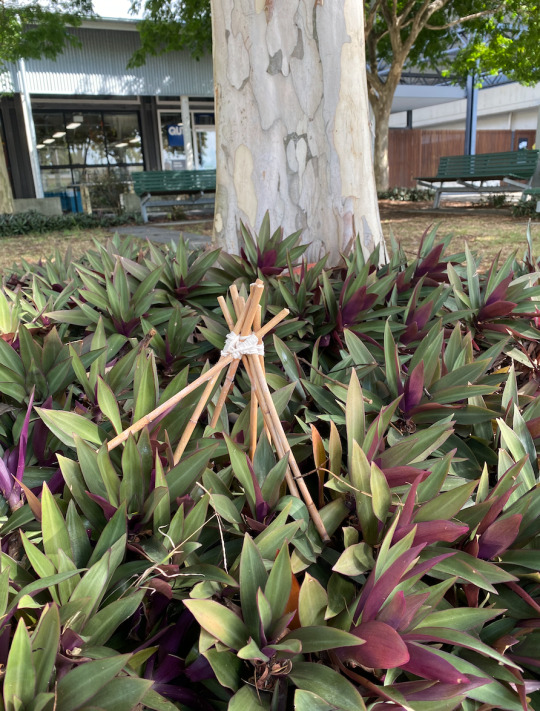
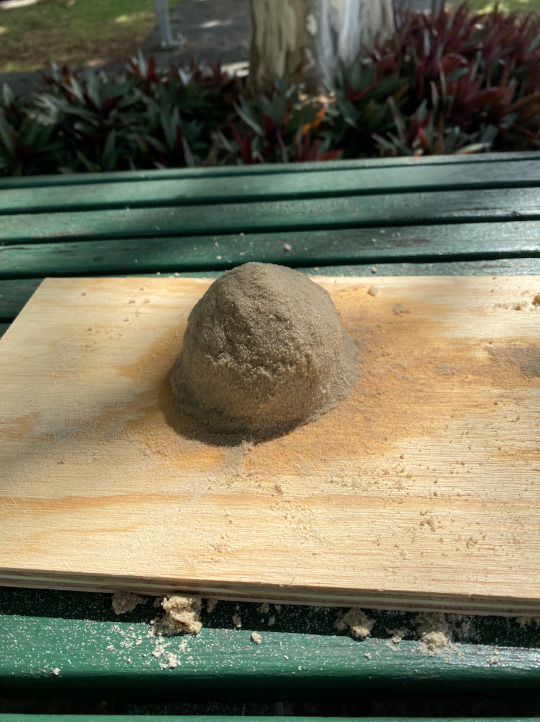
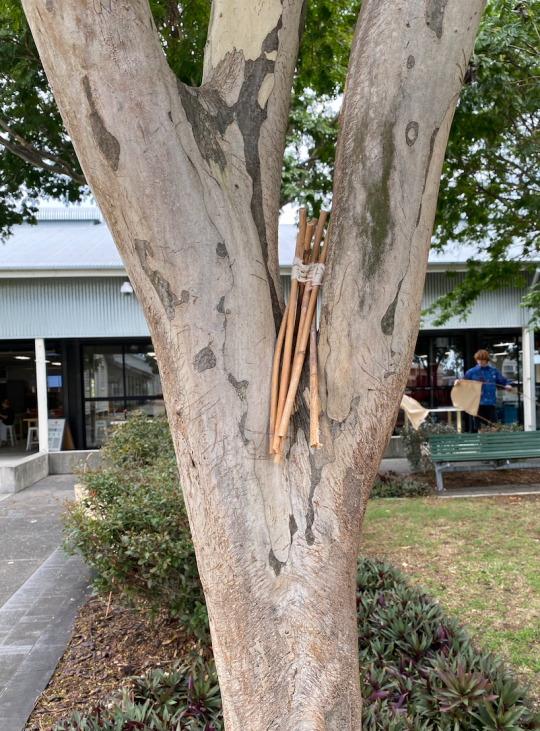
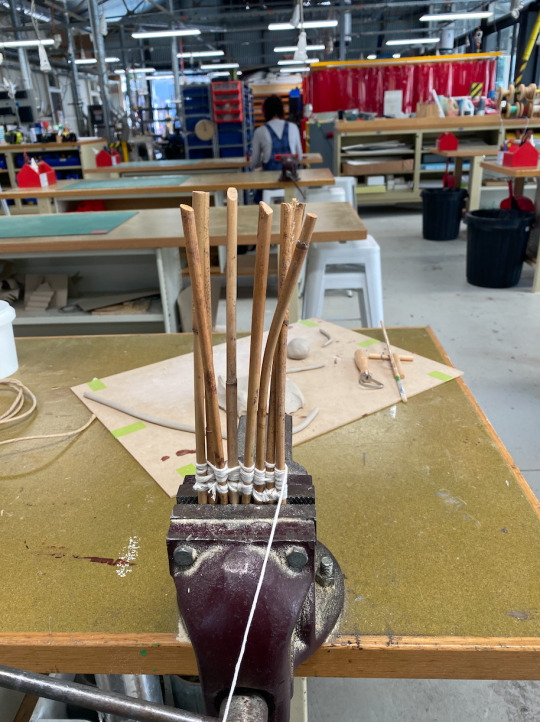
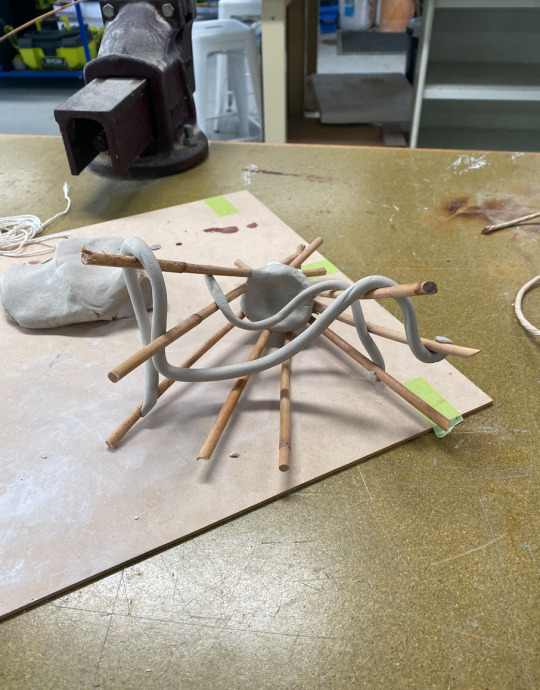
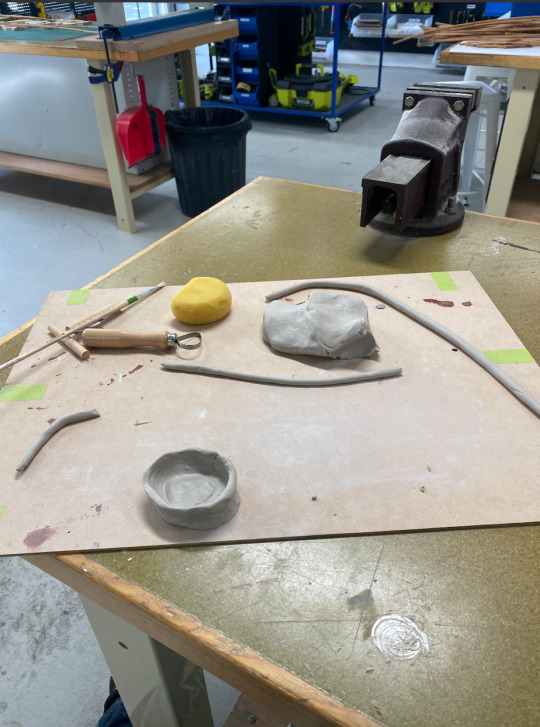

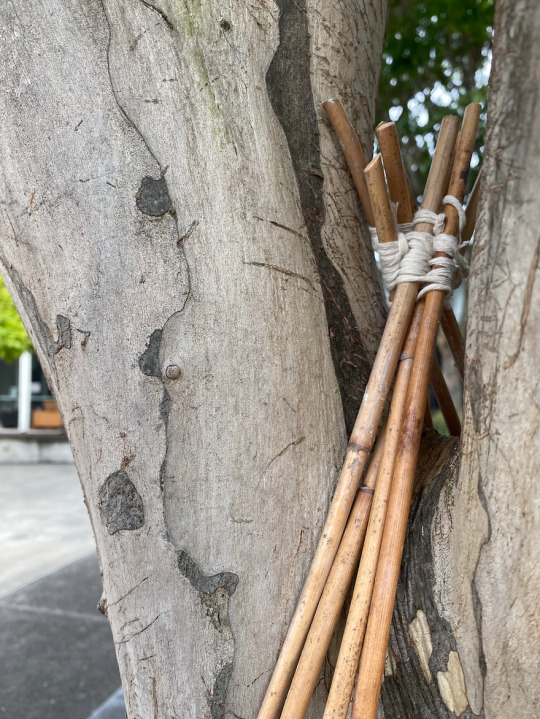
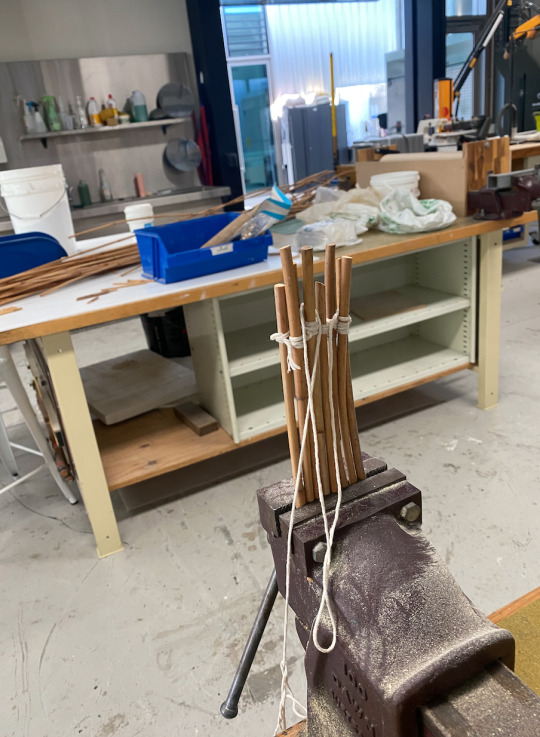

Week 4
In this week's task, I mistakingly read the brief wrong. Thinking we could use any material we wanted instead of only two. After creating a bamboo structure by weaving beige thread in and out between each stick. These created a triangular-prism shape which was interesting to the eye. However, the shape wasn't stable which is why I added a chunk of clay at the button of the prism and met the string at the base. As well as this I began adding curving lines made out of clay which made interesting shadows and patterns on the ground. After creating this work, my classmates reminded me that it was only two materials for a work. I removed the clay and tried to consider where this structure could go. Originally I saw the work with clay referencing ideas of a chair as a place to sit and rest. This idea was no longer applicable to the work after the clay. I didn't want to remake the work with string as I wanted to try and experiment more with what I had already. I started thinking of options and considered ideas for shelter. These ideas of homelyness or shelter have become a reoccurring idea within my iterative practice this semester. I placed my object within the branches of a tree close by shielding a small area of a tree with the sticks. I began to think of the work as a place for ants or insects to rest. This leads me to add a small rope hanging down acting as a ladder to get up and down the tree. I tied small notes in the rope resembling ropes in playgrounds.
I was happy with what I had created with the straight lines and interconnectedness of the string. However, when reflecting on the work I was stuck on this idea of playgrounds and childhood. I considered my own upbringing on the Sunshine Coast and making drip castles on the beach. I always imagined creatures living inside the houses I had made on the beach. This is what led me to use sand to create a second work for this week's task. A sandcastle was placed on plywood. I used water to manipulate the texture and structural qualities of the sand. By adding water the sand is no longer as light and becomes more fluid and easily manipulated. this allowed me to form half a sphere and create a bubble texture over the top. This texture is similar to ant nests. I liked how the tan colour of the sand became harder to see.
I really enjoyed this task, It allowed me to continue ideas and become more resilient to change. Allowing the works to be more than one thing.
Charles Simonds (Artist) Specifically his works - Dwellings (Made in the 1970s)
Charles Simonds - Dwellings 1970s
CHARLES-SIMONDS.COM
The works that Simonds creates really helped me imagine ideas within my practice. He creates small dwellings within walls and on the ground with organic materials such as dirt and clay. Our practices are visually similar both creating small places as if insects could live there. He allows the local community to help which I enjoy as spatial art is designed for the public. His work has a levity to it and I think it comes from the process of the work, anything could happen.
Calvin Seibert - https://www.artsy.net/article/artsy-editorial-meet-artist-making-fantastical-modernist-sandcastles
The sand sculptures Seibert creates remind me of childhood. I grew up by the beach and sand has always been a part of me, you take it home with you, leave it in the car, and can’t seem to get it out of your hair. These works remind me that sentimental value can impact how you see a material such as sand which is why his work inspired me to build a less complex castle. Both make a bit of magic for those walking past.
0 notes
Text
Brutalism
Brutalism is an architectural style that places emphasis textures, materials, construction, expression, practicality, and utilitarianism. The style is often characterised by its rough textures, hard edges, rigid geometric shapes, blocky appearances, lack of decoration, simple graphic lines, monochromatic colour palette, and an almost monolithic sense of presence. Scale was a large aspect of brutalist architecture. In addition, brutalism made use of unusual shapes that can easily be differentiated through the use of light and shadow (contrast). Brutalism is memorable and takes up space. Think of a skyscraper: its immense size, the way it takes up space in the open sky, and the way it forever alters your view of the skyline.
Common materials used in brutalist architecture include raw concrete (its most important stylistic motif), brick, glass, steel, and stone.
The term ‘Brutalism’ is derived from the phrase ‘Béton brut,’ which means raw concrete. Brutalist architecture can be observed as far back as the 1940s, with the first example being Le Corbusier’s Unité d’Habitation in Marseilles, France.
The style emerged during the 20th century modernist movement, with the term first being coined in 1949 by Swedish architect Hans Asplun to describe the Villa Göth in Uppsala. The term was then popularised in 1955 when it was used by architectural historian Reyner Banham, when reviewing a school at Hunstanton, Norfolk.
The style grew in popularity through the 1950s and ‘60s, and became the favoured form of architecture for government buildings.
Brutalism as a philosophy focused on bringing modern, developed, almost utopian environments to life. This was a post-WWII era, where urban reconstruction was a pressing matter. Many of the European cities were damaged by bombs and the end of a World War meant a population boom for the US and Europe. This meant that architects needed to design large scale institutional buildings as well as high density affordable residential complexes. The 1950s and 60s was also a time of great technological and social development, creating this culture of optimism and hope for a better future. This zeitgeist was reflected in brutalism; with the movement focusing on functionality and community, and becoming synonymous with socially progressive housing plans that depicted the modern utopian buildings of the future.
Brutalism eventually fell out of style in the 1980s and ‘90s, when the architecture became associated with urban decay, crime, social depravity, economic hardship, and anti-environmentalism. This was partially due to the fact that the raw concrete did not age well, often being prone to decay and water damage. The style also began to be seen as cold, alienating, and lacking in humanity. In addition, due to the architecture being adopted by the Soviet Union, the style began to become associated with totalitarianism, dictatorship, and social control/conformity. This was the period of the Cold War, and therefore the height of the Red Scare, thus creating a widespread fear of communism in the west that Brutalism unfortunately suffered from.
The Brutalist Playground (2015)
Simon Terrill collaborated with Assemble to create a brutalist art installation that “recreated a trio of post-war play structures out of foam.” The installation was displayed at the Royal British Institute of British Architects gallery. The playground was inspired by the Churchill Gardens in Pimlico, the Brownfield Estate in Poplar, and the Brunel Estate in Paddington. Terrill recreated these structures using colourful foam.
Simon Terrill
Simon Terrill is an Australian artist based in London who is preoccupied by the relationship between architecture and the narratives and stories we construct around these spaces. He explores how spaces are constructed and informed by the people that inhabit it.
This greatly relates to our study of heterotopias, as a primary characteristic of heterotopias is how it is constructed as a closed off space for specific social functions, and how it changes over time as society changes around it.
0 notes
Link
#Anshen+Allen#AnshenandAllen#BestSantaClaraAgent#MackayArchitecture#MackayHomes#MackayRealEstate#MackayRealtor#MackaySpecialist#MidModHomes#MidModRealEstate#mid-centurymodern#Mid-CenturyModernHomes#MidMod#modernhomes#SantaClaraArchitecture#SantaClaraHomes#SantaClaraProperty#SantaClaraRealEstate#SantaClaraRealEstateAgent#SantaClaraRealtor#SunshineMeadowHomeSales#SunshineMeadows#SunshineMeadowsHomes#SunshineMeadowsProperty#TopSantaClaraAgent
0 notes
Text
Flats in Smart World One DXP - A Fresh Beginning Towards A Beautiful Life at Sector 113 Gurugram
Smart World One DXP is undoubtedly a marvel development at Sector 113, and is surely a prestigious development for those who wish to have a house of their particular in a prosperous city, and gives a place to live in the best of places with accessibility to the essential areas as well as the prices of the presence of the apartment reasonable to all.
So that one can get the benefit of living in a periphery with the perk of relishing life at a peaceful and affordable criterion. Pre-Launch Smart World One DXP Gurgaon project is Offering the accommodation of 2BHK & 3BHK High-Rise Apartments each of them made with rather an importance.

The development type of the project is an apartment complex, the project is still ongoing and will soon be delivered as properly ready. It proposes an excessive deal of security and also a whole range of other amenities which will upgrade your living standard, and will be a booster of your happiness, pavilion area, multipurpose court, table tennis area, and many others, a huge basketball court, beach volleyball courts, terrace playground, mini soccer arena, some of them are as follows; none of them have left behind the requirements of a modern and an ideal buyer who wishes to invest in a futuristic project of integrity in the substructure and architecture.
Smart World One DXP Upcoming project in Dwarka Expressway, Gurugram is prominent in its very existence and has crossed the benchmarks set by ordinary or also the developing projects.

This being focused on meeting all the requirements at a reasonable price has also defined that the master plan of the project will not leave one unsatisfied, spacious room, well-ventilated areas, a construction which is modernistic and well crafted, no wastage of space, lovely designing of the rooms, and many such more specifications of the floor plan can thus be seen. Also talking about the thoughtfulness of the project’s accurate position and suitability of the commute to places from the place is surely a huge advantage.
#Smart World One DXP#Smart World One DXP Sector 113#Smart World One DXP Sector 113 Gurgaon#Smart World One DXP Gurgaon#Smart World One DXP Sector 113 Gurugram#2BHK Apartments in Smart World One DXP#3BHK Apartments in Smart World One DXP#Smart World One DXP Apartments in Gurgaon#Smart World One DXP in Sector 113 Gurugram#Flats in Smart World One DXP#Smart World One DXP in Sector 113#Smart World One DXP in Sector 113 Gurgaon#Pre-Launch Smart World One DXP Sector 113 Gurugram#Smart World One DXP Upcoming Project in Gurgaon#Smart World One DXP Project in Sector 113#Smart World One DXP Project in Sector 113 Gurgaon#Smart World One DXP Apartments in Sector 113#Smart World One DXP Upcoming Flats in 113#Smart World One DXP Sector 113 in Gurugram#Smart World One DXP Sector 113 in Gurgaon#Smart World One DXP Residential Project in Gurgaon#Smart World One DXP Residences in Sector 113#Smart World One DXP 113 Project in Gurugram#Smart World One DXP Sector 113 Apartments in Gurgaon#Smart World Sector 113#Smart World Sector 113 Gurgaon#Smart World Sector 113 Gurugram#Smart World Upcoming Apartments in Sector 113#Smart World Upcoming Flats in 113 Gurugram#Smart World One DXP Project Gurugram
1 note
·
View note
Photo

modernist playground, c.1971 redditch, worcestershire.
2K notes
·
View notes
Text

park hill
14 notes
·
View notes
Photo




The playground project
Second, expanded edition.Burkhalter, Gabriela, editor.; Shields, Andrew, translator.; Kunst- und Ausstellungshalle der Bundesrepublik Deutschland, host institution.Zürich : JRP/Ringier 2018
64 notes
·
View notes
Text
Exploring the Vibrant Art and Culture Capitals Worldwide

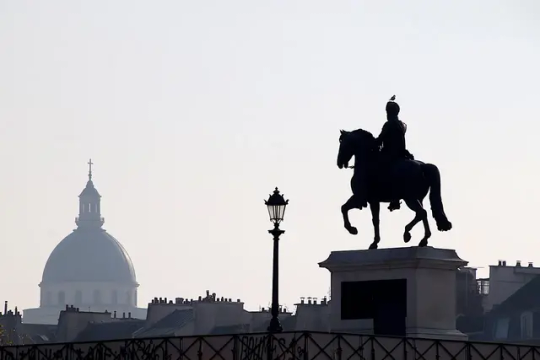
In the realm of travel, some cities stand out not just for their architectural grandeur or culinary delights, but as true bastions of art and culture. These are the Art and Culture Capitals, where the spirit of human expression and creativity finds its most profound manifestation. In this blog post, we'll embark on a journey through some of the world's foremost cities that serve as epicenters for the arts, offering a deep dive into the cultural tapestry that defines them.
Art and Culture Capitals

Paris, France: The City of Light and Creativity Paris, often hailed as the City of Light, is an unparalleled hub of art and culture. With iconic landmarks like the Louvre Museum, home to masterpieces like the Mona Lisa, and the Musée d'Orsay, showcasing an extensive collection of Impressionist masterpieces, Paris is a visual feast for art enthusiasts. The city's bohemian neighborhoods, historic theaters, and vibrant street art further contribute to its status as a global cultural capital. Florence, Italy: Renaissance Marvels in the Tuscan Hills Nestled in the heart of Tuscany, Florence stands as a testament to the Renaissance period, with its architectural marvels and world-renowned art collections. The Uffizi Gallery houses works by Botticelli, Leonardo da Vinci, and Michelangelo, while the Florence Cathedral and the Palazzo Vecchio showcase the city's rich history. Florence's intimate connection to the arts is woven into its very fabric, making it a must-visit for those seeking cultural immersion. Vienna, Austria: Symphony of Arts in the Imperial City Vienna, the imperial city on the banks of the Danube, resonates with a symphony of arts and culture. The Vienna State Opera, the Belvedere Palace with Gustav Klimt's "The Kiss," and the MuseumsQuartier exemplify the city's commitment to artistic excellence. As the birthplace of renowned composers like Mozart and Beethoven, Vienna's musical legacy adds a dynamic layer to its cultural landscape, making it an indispensable destination for art connoisseurs. New York City, USA: The Cultural Melting Pot As a melting pot of cultures and ideas, New York City stands at the forefront of the global art scene. From the iconic Metropolitan Museum of Art to the cutting-edge contemporary exhibits at the Museum of Modern Art (MoMA), the city offers a diverse range of artistic experiences. Broadway theaters, street art in neighborhoods like Bushwick, and cultural events like the Tribeca Film Festival contribute to New York's status as a dynamic cultural capital. Barcelona, Spain: Gaudí's Playground and Modernista Marvels Barcelona, with its unique blend of Catalan culture and modernist architecture, is a treasure trove for art enthusiasts. Antoni Gaudí's masterpieces, including the Sagrada Família and Park Güell, showcase the city's avant-garde spirit. The Picasso Museum and the Joan Miró Foundation further contribute to Barcelona's artistic allure. The city's vibrant street life, festivals, and flamenco performances add a lively rhythm to its cultural richness. Tokyo, Japan: The Fusion of Tradition and Innovation Tokyo, a city where tradition meets cutting-edge innovation, has emerged as a vibrant center for contemporary art and culture. The Mori Art Museum, teamLab Borderless digital art museum, and traditional theaters like Kabuki-za exemplify Tokyo's diverse cultural offerings. The city's districts, from the historic Asakusa to the futuristic Akihabara, create a dynamic tapestry that reflects Japan's rich heritage and modern creativity. Berlin, Germany: Street Art Capital and Creative Hub Berlin, with its gritty charm and vibrant energy, has established itself as a global hub for contemporary art and culture. The East Side Gallery, a stretch of the Berlin Wall adorned with murals, symbolizes the city's resilience and artistic expression. The city's diverse neighborhoods, creative spaces like the Kunsthaus Tacheles, and events like Berlin Art Week make it a mecca for those seeking an avant-garde cultural experience. Art and Culture Capitals serve as beacons of human creativity, inviting travelers to explore the depth and diversity of artistic expression across the globe. Whether you're captivated by the classical elegance of Paris, the Renaissance wonders of Florence, or the cutting-edge innovation of Tokyo, each city on this list offers a unique perspective on the intersection of art, culture, and the human spirit. So, pack your cultural curiosity and embark on a journey through these vibrant metropolises, where the world's artistic pulse beats strongest.
Must-visit cultural capitals

For the avid traveler seeking a rich tapestry of history, art, and cultural diversity, the world is dotted with must-visit cultural capitals that stand as beacons of human creativity. In this blog post, we'll embark on a global odyssey, exploring some of the most captivating cities that have earned their place as must-visit cultural capitals, each offering a unique and enriching experience. Paris, France: The Eternal City of Art and Romance Paris, often deemed the "City of Light," effortlessly earns its place as a must-visit cultural capital. Beyond the iconic Eiffel Tower and the charming streets lined with bistros, Paris is home to world-class museums and art galleries. The Louvre, housing the enigmatic Mona Lisa, and the Musée d'Orsay, showcasing masterpieces of Impressionist art, make Paris a haven for art enthusiasts. The city's architectural marvels, historical landmarks, and the poetic ambiance of the Seine River contribute to its unparalleled cultural allure. Rome, Italy: The Eternal City of Antiquity Rome, with its ancient ruins, awe-inspiring architecture, and rich history, beckons travelers to immerse themselves in the cultural legacy of the Roman Empire. The Colosseum, the Roman Forum, and the Pantheon transport visitors to a bygone era. Rome's Vatican City, with St. Peter's Basilica and the Sistine Chapel, adds a spiritual dimension to its cultural wealth. Amidst the cobbled streets and bustling piazzas, every corner of Rome tells a story of antiquity and enduring legacy. Kyoto, Japan: Where Tradition Meets Tranquility Kyoto, with its serene temples, traditional tea houses, and meticulously maintained gardens, is a cultural treasure trove that transports visitors to the heart of Japanese heritage. The Golden Pavilion (Kinkaku-ji), the Fushimi Inari Shrine with its iconic torii gates, and the historic Gion district are testaments to Kyoto's commitment to preserving its cultural identity. The city's annual Gion Matsuri festival and traditional tea ceremonies provide immersive experiences into Japan's cultural tapestry. Cairo, Egypt: Gateway to Ancient Wonders Cairo, situated on the banks of the Nile, is a must-visit cultural capital that serves as the gateway to Egypt's ancient wonders. The Pyramids of Giza, the Sphinx, and the Egyptian Museum house artifacts from pharaonic times, offering an unparalleled journey into the mysteries of ancient civilization. Cairo's Islamic Cairo district, with its historic mosques and bustling bazaars, adds a dynamic layer to the city's cultural richness. Seville, Spain: Flamenco, Festivals, and Moorish Marvels Seville, with its vibrant energy, flamenco rhythms, and architectural marvels, captures the essence of Andalusian culture. The Alcazar of Seville, a stunning palace blending Moorish and Christian influences, and the iconic Giralda tower showcase the city's historical richness. Seville's Semana Santa (Holy Week) and the Feria de Abril (April Fair) add a festive touch, making it a must-visit cultural capital for those seeking a dynamic blend of tradition and celebration. Beijing, China: Imperial Grandeur and Contemporary Contrasts Beijing, China's capital, seamlessly weaves imperial grandeur with contemporary contrasts. The Forbidden City, with its opulent palaces and ancient architecture, stands as a testament to China's imperial history. The Temple of Heaven and the Summer Palace further enrich the city's cultural offerings. Modern Beijing, with its avant-garde art districts like 798 Art Zone, reflects the nation's dynamic spirit and artistic innovation. Mexico City, Mexico: A Tapestry of Mesoamerican and Colonial Heritage Mexico City, nestled in the Valley of Mexico, is a cultural capital that unfolds a vibrant tapestry of Mesoamerican and colonial heritage. The ancient city of Teotihuacan, the historic center with its Zócalo square and the Metropolitan Cathedral, and the Frida Kahlo Museum showcase the city's diverse cultural influences. Mexico City's lively street markets, traditional music, and colorful murals contribute to its dynamic cultural scene. These must-visit cultural capitals beckon travelers to embark on a global odyssey of art, history, and diverse traditions. From the romantic allure of Paris to the ancient wonders of Rome, the tranquil charm of Kyoto to the dynamic energy of Beijing, each city on this list offers a unique cultural experience. Whether you're captivated by the grandeur of imperial palaces, the mysteries of ancient civilizations, or the vibrant celebrations of local festivals, these cultural capitals promise an enriching journey into the heart and soul of human creativity. So, pack your curiosity and explore these cities where the past and present converge to create a cultural tapestry that transcends time.
Art and culture events worldwide

In the vibrant tapestry of our world, art and culture events serve as dynamic threads that weave together diverse stories, traditions, and creative expressions. From international art fairs to cultural festivals that celebrate heritage, this blog post takes you on a global odyssey, exploring the most captivating and enriching art and culture events that unfold across the continents. Venice Biennale, Italy: The Pinnacle of Contemporary Art Every two years, Venice becomes a mecca for contemporary art enthusiasts during the Venice Biennale. Established in 1895, this renowned event showcases a diverse array of visual arts, including painting, sculpture, film, and installations. The historic venues, such as the Giardini and the Arsenale, transform into immersive spaces where artists from around the world converge to push the boundaries of artistic expression. Edinburgh Festival Fringe, Scotland: A Feast of Performing Arts The Edinburgh Festival Fringe, held annually in August, is the world's largest arts festival, attracting performers and audiences from every corner of the globe. The Scottish capital becomes a stage for theater, comedy, dance, and music performances, offering a unique platform for both established artists and emerging talents. With thousands of shows spanning various genres, the festival epitomizes the diversity and creativity of the performing arts. Diwali, India: The Festival of Lights Diwali, the festival of lights, is one of the most significant cultural events in India and among the Indian diaspora worldwide. Celebrated by Hindus, Sikhs, Jains, and Buddhists, Diwali marks the triumph of light over darkness and good over evil. The festival is characterized by colorful decorations, the lighting of lamps (diyas), fireworks, and vibrant cultural performances, making it a visually spectacular and spiritually significant event. Rio Carnival, Brazil: Samba, Color, and Extravaganza The Rio Carnival in Brazil is synonymous with exuberance, music, and dance. Held annually before Lent, this world-famous event transforms the streets of Rio de Janeiro into a pulsating celebration of Brazilian culture. Samba parades, vibrant costumes, and infectious rhythms create an electrifying atmosphere, attracting millions of visitors from around the globe to experience the grandeur of one of the largest carnivals on Earth. Day of the Dead (Día de los Muertos), Mexico: Honoring Ancestors Día de los Muertos, or Day of the Dead, is a poignant and vibrant cultural event in Mexico that honors deceased loved ones. Celebrated from October 31 to November 2, families create elaborate altars (ofrendas) adorned with marigolds, candles, and the favorite foods of the departed. Parades, music, and traditional dances fill the streets, creating a unique and heartfelt atmosphere of remembrance and celebration. Berlin International Film Festival (Berlinale), Germany: A Cinematic Extravaganza The Berlin International Film Festival, known as Berlinale, is one of the most prestigious film festivals globally, attracting filmmakers, actors, and cinephiles alike. Held annually in February, Berlinale screens a diverse range of films, from avant-garde independent productions to high-profile international releases. The festival's unique sections, including the Berlinale Palast screenings and the Forum for New Cinema, contribute to its reputation as a dynamic and influential cultural event. Harbin Ice Festival, China: Frozen Artistry in Winter Wonderland In the frigid winters of Harbin, China, the Ice Festival transforms the city into a breathtaking winter wonderland. Artists from around the world sculpt intricate ice and snow installations, creating a mesmerizing display of frozen artistry. Visitors can explore illuminated ice castles, attend ice lantern shows, and marvel at massive ice sculptures, making it a cultural celebration that embraces the beauty of winter. Art and culture events worldwide provide a window into the rich diversity of human creativity and heritage. Whether you're captivated by the contemporary art scene at the Venice Biennale, enthralled by the pulsating rhythms of the Rio Carnival, or moved by the spiritual significance of Día de los Muertos in Mexico, these events offer unique insights into the global tapestry of cultural expression. As you plan your travels, consider immersing yourself in the vibrant energy of these events, where the world comes together to celebrate the boundless possibilities of human imagination and ingenuity.
Famous art galleries in cultural capitals

Cultural capitals around the world are adorned with renowned art galleries that house some of the most celebrated masterpieces in history. In this blog post, we will embark on a journey to explore the famous art galleries nestled in these cultural hubs, where each stroke of the brush and every chisel mark tells a tale of artistic brilliance and cultural richness. The Louvre, Paris: A Palace of Art and History The Louvre, located in the heart of Paris, is not just a museum; it is an architectural masterpiece and a treasure trove of artistic wonders. Home to the iconic Mona Lisa, the Venus de Milo, and the Winged Victory of Samothrace, the Louvre spans centuries and civilizations. From ancient Egyptian artifacts to Renaissance paintings, the Louvre is a cultural voyage through time, housed within the grandeur of a former royal palace. The Metropolitan Museum of Art (The Met), New York City: The Crown Jewel of Fifth Avenue Nestled along New York City's Fifth Avenue, The Metropolitan Museum of Art, commonly known as The Met, is a cultural beacon that attracts millions of visitors annually. With over two million works of art spanning 5,000 years, The Met is a comprehensive exploration of human creativity. From European paintings to Egyptian artifacts and Asian sculptures, each gallery within The Met offers a unique glimpse into the diverse facets of global artistry. The Vatican Museums, Vatican City: Papal Treasures and Michelangelo's Sistine Chapel In the heart of Vatican City, The Vatican Museums house an extensive collection amassed over centuries by the Catholic Church. The crowning jewel, the Sistine Chapel, adorned with Michelangelo's breathtaking frescoes, is a pilgrimage for art lovers. From Raphael's Rooms to the Gallery of Maps, these museums showcase the opulence of papal treasures and the enduring influence of Renaissance art on the Vatican's cultural legacy. The State Hermitage Museum, St. Petersburg: Imperial Splendor on the Neva River Nestled along the banks of the Neva River, the State Hermitage Museum in St. Petersburg is a cultural gem within the imperial city. Housed in the opulent Winter Palace, the Hermitage is one of the largest and oldest museums in the world. Its vast collection spans from ancient civilizations to contemporary art, featuring works by Rembrandt, da Vinci, and Van Gogh. The grandeur of the Hermitage is not just in its art but in the splendor of its architectural setting. The British Museum, London: A Global Exploration of Human History In the heart of London, The British Museum stands as a testament to the breadth and depth of human history. From the Rosetta Stone to the Elgin Marbles, this museum houses artifacts from every corner of the globe. The Enlightenment Gallery, Egyptian mummies, and the Assyrian Lion Hunt reliefs provide a comprehensive journey through civilizations, making The British Museum a cultural encyclopedia on display. The Uffizi Gallery, Florence: Renaissance Masterpieces on the Arno River Overlooking the Arno River, the Uffizi Gallery in Florence is a celebration of Renaissance art and culture. Home to works by Botticelli, Leonardo da Vinci, and Michelangelo, the Uffizi showcases the artistic brilliance that flourished during the Italian Renaissance. The Vasari Corridor, connecting the Uffizi to the Pitti Palace, adds a touch of intrigue to this cultural haven nestled in the heart of Tuscany. The Prado Museum, Madrid: Spanish Masterpieces and European Artistry In the heart of Madrid, the Prado Museum is a showcase of Spanish artistry and a testament to Europe's cultural heritage. Home to masterpieces by Velázquez, Goya, and El Greco, the Prado captures the evolution of European painting from the 12th to the early 20th century. With over 8,000 paintings on display, the Prado is a captivating journey through the artistic evolution of the Iberian Peninsula and beyond. Famous art galleries in cultural capitals are more than repositories of art; they are living narratives that encapsulate the essence of human creativity and cultural evolution. Read the full article
0 notes